Leaving “No Stone Unturned” for Children with High-Risk Leukemia
3.2.2021 | Seattle Children's Press Team
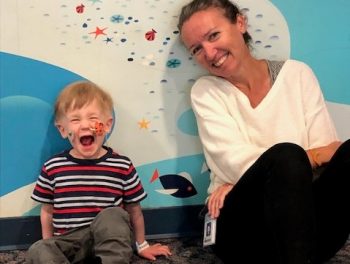
There are two fateful phone calls Robin Lawrence will always remember.
The first, an unexpected late-night call from her son’s pediatrician. He had just reviewed the results from his recent blood work, and something was off. The doctor instructed Robin to immediately take then 13-month-old Henry to the nearest children’s hospital to get it checked out. He said that they had to consider it could be cancer.
She remembered thinking in the moment, “That’s ridiculous. Of course, he doesn’t have cancer.”
Days later, Henry was diagnosed with acute myeloid leukemia (AML), an aggressive childhood cancer.
The second call occurred not long after Henry’s leukemia returned for a third time. At the time, Henry was in between treatments. Another round of chemotherapy had temporarily put the cancer into remission, but the Lawrences knew the statistics were not in their favor. The likelihood the leukemia would come back was high.
Their conversation was the first of many with Dr. Todd Cooper, co-interim division chief of Seattle Children’s Cancer and Blood Disorders Center and director of Seattle Children’s High-Risk Leukemia Program, as part of a second opinion service the program offers.
By the end of the call, Robin and her husband, David, knew Seattle Children’s was the best place for Henry should the cancer ever come back. In the coming weeks, they decided to move from their home in Southern California to Seattle for Henry’s medical care.
“When we talked to Dr. Cooper, it was very clear to us that Seattle Children’s is on the forefront of cutting-edge research and treatments for pediatric high-risk leukemia,” Robin said. “Our son’s cancer was in remission, but we understood that it was very likely to recur. We wanted to be in Seattle, ready to get whatever the best care for Henry would be when that time came.”
A team of high-risk leukemia experts
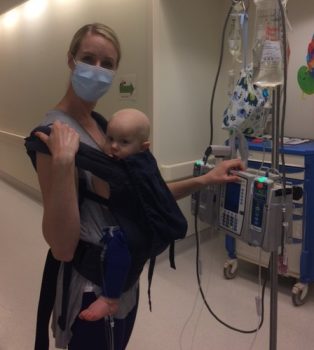 Acute lymphoblastic leukemia (ALL) and AML, the most common leukemias in children, are considered high-risk if they don’t respond well to initial therapy or have biologic markers that predict it is more likely to come back after treatment. Many children with high-risk leukemia will likely need a bone marrow transplant (BMT) as part of their treatment.
Acute lymphoblastic leukemia (ALL) and AML, the most common leukemias in children, are considered high-risk if they don’t respond well to initial therapy or have biologic markers that predict it is more likely to come back after treatment. Many children with high-risk leukemia will likely need a bone marrow transplant (BMT) as part of their treatment.
Cooper, with Dr. Marie Bleakley, a pediatric bone marrow transplant specialist at Seattle Children’s, helped establish the High-Risk Leukemia Program in 2018 to bring together a team of top experts in all disciplines specific to a child’s unique needs to provide seamless, coordinated care.
Among the program’s many features, is a needed bridge between Seattle Children’s leukemia team and the bone marrow transplant team. Historically, a child in need of transplant would transfer from the care of their Seattle Children’s leukemia team to their bone marrow transplant team. The leukemia team would have little communication with the transplant team or family until after the child had recovered from all the short- and long-term effects of transplant.
Cooper saw the potential gaps this created and understood the benefit in having all the experts in treating childhood high-risk leukemia involved in making decisions about the child’s care from day one.
“Seattle Children’s and its partners, Fred Hutchinson Cancer Research Center and Seattle Cancer Care Alliance, have a critical mass of the country’s top pediatric leukemia oncologists and nurses, bone marrow transplant providers, AML and ALL cancer biologists and cancer immunotherapy researchers,” Cooper said. “We had an incredible level of expertise, we only needed to be more integrated to improve the way we took care of kids with complex blood cancers and so we decided to change the model of care. If something happened to me or my family and I were put in this position, I would want to make sure that all the best minds are coming together to care for my family.”
Finding “their person”
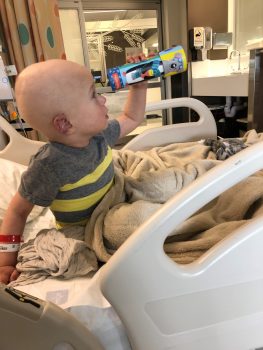 Within days of arriving in Seattle, Henry had his first appointment with Cooper and the High-Risk Leukemia team.
Within days of arriving in Seattle, Henry had his first appointment with Cooper and the High-Risk Leukemia team.
The family first met with Shauna Sinclair, a dedicated nurse coordinator with the program. Sinclair works closely with both the family and providers to coordinate a child’s comprehensive care. As the family’s primary contact, she manages their appointments, provides education about what’s to come, is frequently checking in to intercept any concerns and helps plan for a child’s transplant if that is part of their leukemia treatment.
According to Sinclair, an oncology nurse with over 20 years of experience both in the Cancer Unit and on the transplant research side, she seeks to become “their person.”
“Families never wish to be on this journey, and it can be very isolating as their friends and relatives often don’t understand what it’s like,” she said. “While I haven’t lived this experience either, I have been given a window into the life of these amazing families and some of the things they have to endure, so I try to make a difference where I can and just care. It comes through in my check-ins, my explanations, my coordination, my listening and my advocacy.”
Large academic hospitals like Seattle Children’s have numerous benefits, but a downside is that it can feel daunting with all the different people involved in care. Robin says Sinclair made it clear from the get-go that they should never hesitate to bring any of their questions or concerns to her.
“It meant everything to us as the parents of three young children and one who at various times has been critically ill, to have someone on our team who I just knew always had our backs,” Robin said. “That took a huge burden off of us.”
“No stone unturned”

Beyond the care coordination, another important component of the high-risk leukemia model is its portal into Seattle Children’s robust cancer research program.
“The success of the program is dependent on having options for children with high-risk leukemia,” Cooper said. “The most innovative therapies and next generation diagnostics are provided through clinical trials and we must learn more in order to transform treatment and improve outcomes.”
Through research studies, the program offers all high-risk leukemia patients at Seattle Children’s next generation sequencing of their cancer. The sequencing can find the genetic changes that make some forms of leukemia harder to cure. Results from sequencing can help identify and develop better treatments targeted at those genetic changes.
“We’re furthering research by interrogating samples from these very rare leukemias, leaving no stone unturned in order to provide options to our families,” Cooper said. “For many of our patients, the sequencing results are significant and can alter our treatment if a more targeted therapy exists.”
Cooper is also leading large national and international clinical trials offered through the Children’s Oncology Group and the Leukemia and Lymphoma Society to improve therapies for pediatric leukemia.
He notes that many high-risk leukemia patients are candidates for one of Seattle Children’s chimeric antigen receptor (CAR) T-cell immunotherapy clinical trials. The team is planning new clinical trials that extend experimental cancer immunotherapies, which have achieved transformational results in relapsed ALL, to AML. Cooper anticipates phase 1 trials will be open at Seattle Children’s to children with AML within the year.
Managing complexity
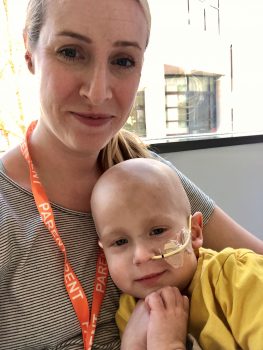 Since the family’s first visit, Cooper, Sinclair and the rest of the High-Risk Leukemia team have always had options for Henry throughout the ups and downs of managing his complex medical treatment.
Since the family’s first visit, Cooper, Sinclair and the rest of the High-Risk Leukemia team have always had options for Henry throughout the ups and downs of managing his complex medical treatment.
By developing a personalized surveillance plan so that if Henry’s cancer did return, they would find it as early as possible to get access to an experimental drug when Henry relapsed in March 2019. Robin says they always trusted that he was in good hands.
“That’s why it’s so important for us to be at a place like Seattle Children’s,” Robin said. “They see the things that are unusual and are comfortable managing all the complexities.”
In the summer of 2019, after a long and difficult hospital stay due to an aggressive round of chemotherapy, the family decided to pursue a second bone marrow transplant for Henry. Henry’s first transplant while the family was still in California was fraught with complications. His parents vowed to never to put him through something like that again.
The decision they faced was grueling. A second transplant offered the only path to a cure.
“It took us several weeks to reach a decision, but Dr. Cooper and his transplant team led by Dr. Bleakley pulled together to help us figure out what would be best for Henry,” Robin said. “A unique aspect of the leukemia team at Seattle Children’s is that they’re both willing to be aggressive and go above and beyond to give a child a chance at living and being cured, and they’re also really respectful of what is best for the child and what the family thinks is best for the child, which for us, was focused on Henry’s quality of life.”
Prioritizing Henry
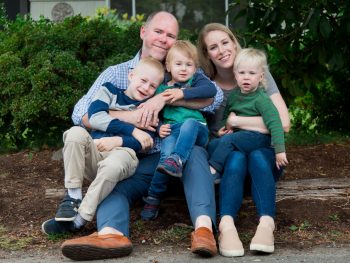 This month marks 18-months of remission since Henry’s transplant. It’s the longest he’s been in remission since his diagnosis. While the transplant was a success, his parents recognize that there are no guarantees with an aggressive cancer like the one Henry had.
This month marks 18-months of remission since Henry’s transplant. It’s the longest he’s been in remission since his diagnosis. While the transplant was a success, his parents recognize that there are no guarantees with an aggressive cancer like the one Henry had.
“Our dream for Henry is that he’s cured,” Robin said. “We know that there’s a high likelihood that he’s not cured, but every day that goes by that he is in remission gives us hope that maybe he is cured.”
Sinclair continues to work closely with the family and Henry’s transplant coordinator in the bone marrow transition clinic at Seattle Children’s, keeping tabs on his ongoing care plan and progress.
“Their concern for his well being is palpable,” she said. “Prior to transplant, it was agonizing for them to know the right choices for Henry. They weighed absolutely everything to make the best choice for him. I’ve come to learn that ultimately I don’t know the trajectory of a patient’s disease or what hurdles they need to overcome during treatment, but what I can control is how I care for patients and families.”
Part of that care means Henry is seen as a whole person, the sweet, truck-loving 4-year-old who eagerly awaits “hospital days” when his weekly appointments are scheduled. Robin says Henry knows Seattle Children’s is a place where people love him and take care of him.
“Not only has the clinical care been nothing short of extraordinary, the social support we have received from psychology, occupational and speech therapy is phenomenal too,” Robin said. “Everyone has prioritized making his time at Seattle Children’s special for him. The doctors and nurses, our nurse practitioner, the people who check us in and the child life specialist who keeps a stash of his favorite brown lollipops – they all see Henry for the sweet little boy he is and treat all of his needs.”
High-Risk Leukemia Second Opinion Service
If a doctor at another hospital or clinic has diagnosed your child with high-risk leukemia, you can request a second opinion with us. Our High-Risk Leukemia Program provides multidisciplinary consults with pediatric oncologists, and our bone marrow transplant and immunotherapy teams.
Contact highriskleukemiateam@seattlechildrens.org or 206-987-2106.
Leukemia Clinical Trials
For a list of leukemia clinical trials, visit Seattle Children’s Current Research Studies website.
Learn more about Dr. Todd Cooper’s leadership with the PedAL Initiative, the first integrated worldwide pediatric acute leukemia effort.